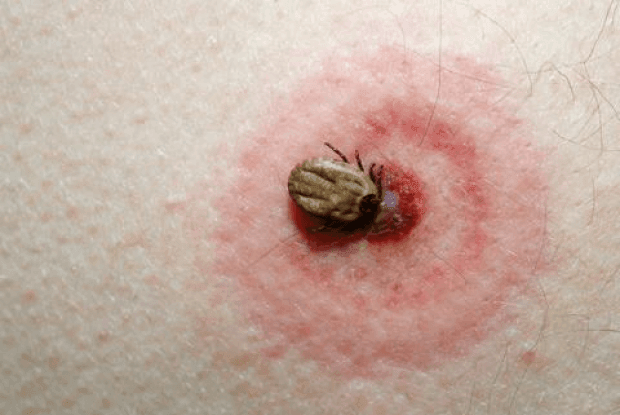A friend of mine at karate told me yesterday that he found 4 ticks on his clothes after he and his wife went for a walk in the woods.
So that was my inspiration to spread the word about Lyme disease ASAP!
Despite Lyme disease’s ever-growing prevalence, many people still don’t fully understand it, or think that all you need is an antibiotic if you get it.
Here’s what you must know--the complete story on Lyme disease, and how you can fight back or prevent it.
The origins of Lyme disease
Lyme disease originated around 1975 and was named after the town of Lyme, Connecticut, where it was first identified.
Within two years, the deer tick was linked to the infection.
Then in 1982, scientist Willy Burgdorfer, Ph.D discovered the bacterium responsible for the infection and named it after himself--Borrelia burgdorferi. Interestingly, it is a cousin of the bacterium that causes syphilis.
The Lyme bacterium is extremely resourceful and has a knack for hiding and survival. It can live inside your cells and encase itself in a “cyst.” That’s why treatment can be so difficult and it can recur after antibiotics.
It’s also difficult to diagnose. There are many species of the Lyme bacterium, but only a handful of strains are detectable with lab tests.
It starts with a tick bite—or maybe not!
The typical Lyme infection starts when a tick that’s carrying the bacterium jumps off a deer, bird, rodent or other animal and latches onto you.
It immediately starts numbing your skin so you can’t feel it. It prefers dark, secluded areas such as your armpits, behind your ear or your scalp.
But ticks aren’t the only guilty parties. Lyme can also be spread by mosquitoes, spiders, fleas, and mites.
After being bitten, one of the first signs of Lyme is a bulls-eye-like rash on your skin, but if a tick didn’t do the biting (and you were instead bitten by another Lyme-carrying insect), the rash may be shaped differently.
In addition, you might not get a rash at all! Fewer than 50 percent of people who contract Lyme don’t recall getting a rash, and the CDC estimates that at least 30 percent of Lyme sufferers do not develop a rash.
Other signs of Lyme infection include flu-like symptoms such as fever, body aches, poor sleep, fatigue and chills.
It’s not that rare and it’s often missed
According to the CDC, 300,000 new cases of Lyme disease are diagnosed in the US each year—that’s 1 1/2 times the number of people who are diagnosed with breast cancer each year…so it’s not as rare as you might think.
As far as testing goes, current estimates show that the standard ELISA test misses at least 35 percent of Lyme cases.
That’s because the Lyme bacterium can infect your white blood cells, and when this happens, they don't respond by producing antibodies like they should. Since the blood tests measure antibody production, you can get a false negative.
So people can suffer for a long time without being properly diagnosed!
It can become chronic
Lyme is typically treated with antibiotics, but some people don’t fully recover after the initial treatment and their condition becomes chronic. This is especially true of people who have weak immune function. Then you may be facing even stronger antibiotics as well as pain medications, steroids and/or anti-inflammatories.
When Lyme becomes chronic, people can suffer ongoing symptoms for months or years, and incur a significant impact on their quality of life.
Problems associated with chronic Lyme infection include debilitating fatigue, joint pains, arthritis, digestive problems, depression, and even cognitive changes like headaches, difficulty concentrating, forgetfulness, and brain fog.
Prevention first!
As is the case for most illnesses, prevention is the key with Lyme disease.
If you spend time outdoors, check for ticks daily on yourself, children and pets.
Use a non-toxic, natural insect repellant. You can make your own by combining ½ cup witch hazel, ½ cup organic apple cider vinegar, and 30-50 drops of essential oils of your choice in a spray bottle.
Bathe or shower within two hours after coming in from the outdoors if possible.
If you’ve been in a tick-infested area, do a full body check and examine your clothing for ticks. Tossing your clothes in the dryer on high heat for an hour will kill any you may have missed.
And see a doctor immediately if you develop a bull’s-eye or other suspicious rash.
Other ways to fight back
1- Engage the power of the right diet
Nourishing your body with a healthy diet is number one.
Having a nutritious diet of whole foods helps create a healthier gut environment. Since your gut is where most of your immune system resides, by promoting gut health, you are also supporting strong immune function!
Plus antioxidant vitamins and minerals can help fight the damage caused by infections and viruses, and the phytochemicals found in fruits and vegetables have been shown to have immune-enhancing properties.
My Great Taste No Pain health system can guide you on having a healthy, nutrient-rich diet that is positively delicious (thanks to my outstanding recipes!), as well as show you how to construct meals that are easier for your system to digest.
So you can help prevent Lyme disease AND eliminate gas, bloating and heartburn too!
2- Supplement with probiotics and vitamin D
Having a strong immune system is critical to fighting and preventing infections of all kinds—especially Lyme disease—and when it comes to immune support, probiotics and vitamin D are the Superstars.
Super Shield multi-strain probiotic formula can help keep your population of friendly gut bacteria strong and help support your immune system’s fight against “invaders” like viruses and bacterial infections. Plus Super Shield’s full-spectrum blend of 13 probiotic strains can help your gut microbiome bounce back from the harmful hit it takes from antibiotics.
Vitamin D is crucial to help control your immune system’s inflammatory responses—and the aches, pains and fever associated with Lyme are all inflammatory reactions. Since vitamin D is a common deficiency (primarily due to limited food sources and our avoidance of the sun), supplementing with a top-notch formula like Optimum DK Formula with FruiteX-B can ensure your body has what it needs.
Optimum DK Formula gives you a whopping 5,000 IU’s of vitamin D3, plus vitamins K1 and K2 and the mineral boron, to provide top-notch immune support.
3- Additional helpful foods
Here are other foods that can fight Lyme disease and other infections:
- Foods such as garlic, leeks, onions, radishes and cabbage have anti-infectious properties.
- Helpful spices include thyme, fennel, clove, cayenne pepper, turmeric and ginger.
- Mushrooms including cordyceps, reishi and maitake have been shown to activate immune response.
To your health,
Sherry Brescia












Hello Lisa! We had not come across this before! But it certainly seems to make sense and have merit.
Sherry did some reading and found a very favorable study showing improvements for men in physical rehabilitation. It was a small study, but nonetheless, we would think it’s worth a shot. It appears that some doctor’s and chiropractic offices may have this equipment, so that would be a good way to try it out!
What are your thoughts of adding the BEMER microcirculation device to enhance general blood flow, nutrient and oxygen supply and waste disposal and sleep management?